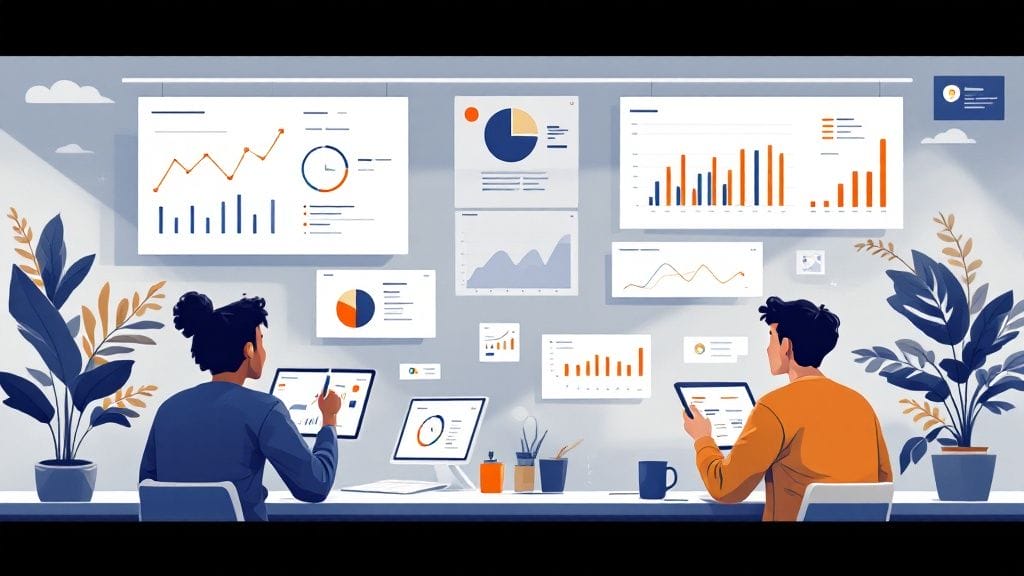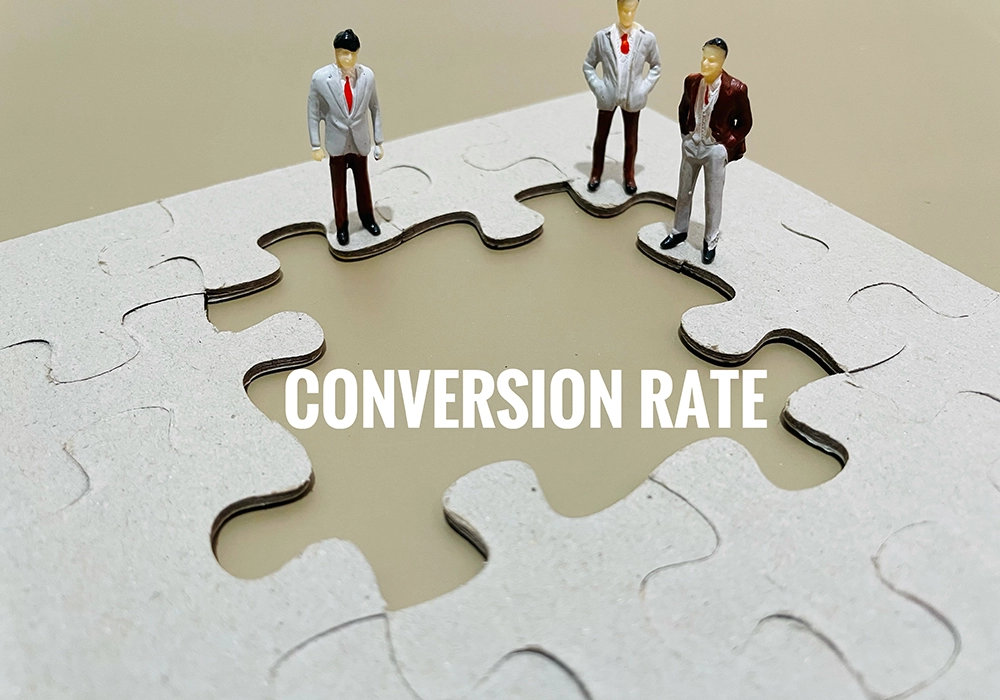Understanding Ecommerce Conversion Benchmarks That Matter
Before optimizing your ecommerce conversion rate, it’s essential to understand your current performance. This goes beyond simply checking your overall rate. It requires a closer look at the benchmarks that truly drive success. This section helps you put your store’s performance into perspective and identify areas for improvement.
Why Industry Benchmarks Are Essential
Comparing your conversion rate to the global average can be misleading. The ecommerce world is incredibly diverse, with each industry having its own customer behaviors and sales cycles. Think about it: someone buying groceries online will likely convert much faster than someone buying expensive jewelry.
A “low” conversion rate in one sector might be perfectly normal in another. Optimizing ecommerce conversion rates relies on understanding these industry differences. The global average ecommerce conversion rate hovers around 3.21%, but this number varies significantly.
To illustrate this point, let’s look at some specific sectors. The Food & Beverage industry enjoys a robust 5.93% conversion rate. On the other hand, Luxury & Jewelry sits at a lower 1.19%. For more detailed information, check out this resource: Learn more about conversion rate benchmarks.
To help you visualize these differences, we’ve compiled the following table:
Ecommerce Conversion Rate Benchmarks by Industry
A comparison of average conversion rates across different ecommerce sectors
| Industry Sector | Average Conversion Rate | Performance vs. Global Average |
|---|---|---|
| Food & Beverage | 5.93% | Significantly Higher |
| Luxury & Jewelry | 1.19% | Significantly Lower |
| Average Across All Industries | 3.21% | Baseline |
As the table shows, conversion rates can fluctuate dramatically depending on the industry. Understanding these benchmarks is crucial for setting realistic goals and developing effective strategies.
Identifying Key Metrics
While your overall conversion rate provides a high-level view, focusing only on that number can hide important details. Other metrics deserve attention. Average order value (AOV), for example, can reveal how to increase revenue without needing more conversions. Customer lifetime value (CLTV) shows the long-term impact of optimization efforts.
Segmenting your audience (new vs. returning customers, mobile vs. desktop users) and analyzing their respective conversion rates uncovers additional opportunities. This approach lets you customize strategies for specific customer groups, maximizing your impact.
Moving Beyond Vanity Metrics
Some metrics, while impressive on the surface, don’t offer much actionable information. Website traffic is a vanity metric if it isn’t resulting in sales. A large social media following is meaningless without contributing to your bottom line. For effective optimization, consider using dedicated tools: Conversion Rate Optimization Tools.
Instead of vanity metrics, focus on actionable data directly tied to revenue: add-to-cart rate, checkout abandonment rate, and conversion rate by product category. Focusing on these indicators pinpoints areas for improvement and tracks your strategy’s success. This data-driven approach ensures targeted efforts and tangible results. By understanding your performance relative to relevant benchmarks and focusing on the right metrics, you build a solid foundation for successful ecommerce conversion rate optimization. This knowledge helps you make informed decisions, prioritize efforts, and drive revenue growth.
Site Speed: The Conversion Killer You’re Overlooking

In the world of online shopping, customers value speed and efficiency. They expect websites to load instantly. A slow website can quickly turn potential customers away. This is why site speed is a critical factor in optimizing your ecommerce conversion rate.
The Impact of Speed on Conversions
Imagine your website as a physical store. Would customers stick around if they had to wait in a long line just to get inside? Probably not. A slow website creates a similar experience. It frustrates visitors and sends them straight to your competitors.
Even small delays can have a big impact on your profits. For instance, a one-second delay in page load time can result in a 7% decrease in conversions. On the flip side, a website that loads in under two seconds can boost conversions by up to 15%. Conversion Rate Optimization (CRO) is essential for any successful ecommerce business. Even small CRO improvements can lead to significant revenue gains. Want to learn more about CRO statistics? Find more detailed statistics here.
Identifying Speed Bottlenecks
Before you can improve your site speed, you need to identify the culprits. Many factors can contribute to slow loading times. These speed bottlenecks can include large image files, poorly written code, server issues, and resource-heavy third-party plugins. Finding these bottlenecks is the first step towards effective optimization.
Optimizing for Speed: Practical Strategies
Luckily, improving site speed doesn’t always require a complete website rebuild. Small changes can often make a big difference.
- Image Optimization: Compressing images reduces file sizes without significantly impacting image quality. This leads to faster loading times.
- Server Performance: A reliable hosting provider and optimized server settings are essential for fast website speeds.
- Code Efficiency: Cleaning up unnecessary code and scripts improves website performance and reduces loading times.
Mobile-First Optimization
With the growth of mobile shopping, optimizing your site for mobile is crucial. Mobile users are even less patient than desktop users. A fast mobile experience is essential for conversions. Successful online stores are prioritizing mobile-specific optimizations. This often involves using responsive design to adapt to various screen sizes and streamlining navigation for a smooth mobile experience.
By prioritizing site speed and addressing these key issues, you can dramatically improve your ecommerce conversion rate. This creates a better user experience, increases customer satisfaction, and ultimately boosts your bottom line. Fixing speed bottlenecks ensures a smooth and efficient online experience that encourages conversions and builds customer loyalty.
Crafting Product Pages That Actually Convert

Your product pages are the heart of your online store, the place where browsing becomes buying. This section explores how to optimize these crucial pages to maximize their impact and turn them into powerful conversion engines. We’ll look at how strategic design and compelling content can work together to drive purchase decisions.
Essential Elements of High-Converting Product Pages
Effective product pages do more than just display information. They anticipate what customers need and address any potential concerns they might have. This involves striking the right balance between providing useful information, captivating visuals, and persuasive elements.
Compelling Product Imagery: High-quality images are key to showcasing your products. Offering multiple angles, zoom functionality, and even 360-degree views allows customers to really examine the items. Lifestyle images can further illustrate the product’s value and show how it’s used in everyday life.
Engaging Video Content: Videos are a dynamic way to present your products. Think product demonstrations, customer testimonials, or even short, stylized clips. These can significantly increase engagement and encourage conversions.
Clear and Concise Product Descriptions: Well-written descriptions answer all of a customer’s potential questions. Focus on highlighting key benefits and addressing common concerns to smooth out the buying process. Using bullet points and an easy-to-scan format makes the information more digestible.
Strategic Price Presentation: Displaying your pricing clearly is essential. Highlighting any discounts, promotions, or value-added offers (like free shipping) can also reinforce the perceived value of your products.
The Power of Social Proof
Customer behavior is often influenced by the opinions and experiences of others. Adding social proof elements to your product pages can have a big impact on your conversion rates.
Customer Reviews and Testimonials: Genuine reviews from satisfied customers build trust and credibility. Make sure these reviews are easily visible and prominently displayed on the product page.
Ratings and Star Systems: Star ratings provide a quick visual representation of a product’s overall quality. They also contribute to social proof and can sway purchase decisions.
Social Media Integration: Weaving your social media presence and user-generated content into your product pages can further strengthen social proof and build brand loyalty.
To illustrate the importance of each element, let’s take a look at how they typically impact conversion rates. The following table summarizes the conversion impact, implementation difficulty, and potential quick wins for each element.
Product Page Elements: Conversion Impact Analysis
This table ranks product page elements based on their typical influence on conversion rates, and offers insights into implementation difficulty and opportunities for quick wins.
| Page Element | Conversion Impact (High/Medium/Low) | Implementation Difficulty | Quick Wins |
|---|---|---|---|
| High-Quality Images | High | Medium | Optimize image sizes for faster loading |
| Compelling Videos | High | Medium | Add short product demonstration videos |
| Detailed Descriptions | Medium | Low | Use bullet points and clear formatting |
| Customer Reviews | High | Medium | Implement a review collection system like Reviews.io |
| Clear Pricing | High | Low | Display pricing prominently |
| Social Proof | Medium | Low | Add social media icons and feeds |
Key takeaways from this analysis highlight the significant impact of high-quality visuals (images and videos) and customer reviews on conversions. While these elements might require a moderate implementation effort, focusing on quick wins like image optimization and integrating a review collection system can yield substantial improvements.
Scarcity and Urgency: Ethical Implementation
Creating a sense of scarcity or urgency can be a powerful motivator, but these tactics should always be used ethically. Be upfront about any genuine limitations on stock or special offers without resorting to manipulative practices. Transparency and authenticity build trust with your customers.
For instance, showing a low-stock warning for a truly limited-edition item can encourage conversions without compromising your brand’s reputation. Conversely, using artificial scarcity tactics can damage customer trust.
By focusing on informative content, incorporating social proof, and presenting information clearly, you can transform your product pages into effective sales tools. This approach not only attracts customers but also guides them smoothly through the purchase process, ultimately maximizing your conversion rates and driving revenue growth. This aligns with the core principles of ecommerce conversion rate optimization.
Transforming Your Checkout From Barrier to Gateway

With cart abandonment rates often hovering above 69%, your checkout process can make or break your ecommerce success. This section explores how to optimize this crucial stage, turning a potential point of frustration into a seamless purchase gateway. We’ll see how successful online stores are smoothing out the buying experience.
Identifying Friction Points in the Checkout Process
Several factors can contribute to shoppers abandoning their carts during checkout. Unexpected shipping costs are a common issue, as are complicated forms, limited payment options, and worries about security. These friction points disrupt the flow, prompting potential customers to leave without completing their purchase. Pinpointing these problems is the first step to finding solutions.
Guest Checkout vs. Account Creation: Finding the Right Balance
A guest checkout option simplifies buying for new customers. It removes the hurdle of mandatory account creation, allowing for quicker transactions. However, encouraging account creation provides benefits like order tracking, saved payment info, and personalized product suggestions. Smart businesses often offer both options, giving customers the freedom to choose.
Optimizing Form Fields for Efficiency and Data Collection
Lengthy, complex forms can discourage shoppers. Optimizing forms involves minimizing required information, using clear labels, and incorporating auto-fill functionality whenever possible. This balances the need for customer data with the desire for a speedy and straightforward checkout.
Progress Indicators: Guiding Customers to the Finish Line
A progress indicator acts like a roadmap for the checkout process. It visually guides customers through each step, showing them how far they’ve come and encouraging them to finish. This simple element can significantly decrease abandonment by offering clarity and maintaining buying momentum.
Strategic Payment Method Selection
Providing a range of payment options accommodates different preferences and reduces friction. Accept major credit cards, digital wallets like Apple Pay and Google Pay, and consider buy-now-pay-later services. The wider your range of payment options, the more likely customers will find one that works for them.
Mobile Checkout Design: Optimizing for Smaller Screens
With the growth of mobile commerce, a mobile-friendly checkout is a must-have. This means designing for smaller screens with larger buttons for easy tapping and streamlined navigation to prevent overwhelming users. A well-designed mobile checkout is critical for converting on-the-go shoppers.
Small Adjustments, Big Results: Real-World Examples
Minor tweaks to the checkout flow can often dramatically improve conversion rates. For instance, one business found that simply placing a security badge near the payment fields boosted conversions by 10%. Another saw a 5% increase just by switching the button color from blue to green. These cases demonstrate the importance of ongoing testing and optimization. Continuously analyzing and refining your checkout helps identify and resolve friction points, maximizing your ecommerce conversion rate optimization. This creates a smoother, more user-friendly experience that encourages conversions and builds customer loyalty.
A/B Testing: Beyond Basic Button Colors

A/B testing forms a cornerstone of any successful ecommerce conversion rate optimization (CRO) strategy. Many businesses, however, get stuck tweaking minor details like button colors. They miss out on testing changes that can have a much bigger impact. This section explores how successful ecommerce brands use A/B testing to drive real improvements, going beyond surface-level tweaks to get substantial results.
Identifying High-Impact Test Opportunities
Effective A/B testing begins with finding the areas where changes can make the greatest difference. Instead of testing elements at random, concentrate on areas with high potential.
For instance, testing different product page layouts or checkout processes can yield much more significant results. Simply changing a button’s color is unlikely to have the same effect. Analyzing data on user behavior can help you find these key areas ripe for improvement.
Developing Hypotheses Based on Customer Behavior Insights
The best A/B tests are driven by solid hypotheses based on customer behavior. These hypotheses should be rooted in real data and insights, not just gut feelings.
For example, if your data shows customers abandoning their carts because of a complicated checkout, your hypothesis might be this: simplifying checkout will boost conversions. This data-driven method keeps your tests focused and effective.
Interpreting Results and Avoiding Statistical Traps
After running A/B tests, it’s critical to understand the results. Statistical significance plays a key role. A small lift in conversions might not be statistically significant. This means it could be due to chance, not the change you made.
Understanding statistical significance keeps you from jumping to the wrong conclusions. It helps you base your decisions on solid data.
Frameworks for Prioritizing and Maximizing ROI
Not all A/B tests offer the same potential. Some will have a much larger return on investment (ROI) than others. Prioritizing tests based on their potential impact and the resources needed is crucial. This maximizes your CRO efforts.
A structured framework for prioritization ensures you’re working on the tests with the biggest payoff.
Creating a Sustainable Testing Culture
A/B testing shouldn’t be a one-time event. It’s better to build a culture of testing within your company for ongoing progress. This means supporting experimentation and making decisions based on data.
It also involves building a process for constant learning and refining your tests.
Specific Test Ideas for Ecommerce Elements
Here are some specific A/B test ideas:
- Product Pages: Test different product image layouts, descriptions, and call-to-action placements. Experiment with showcasing social proof, such as reviews and testimonials.
- Category Pages: Test different layouts, filtering, and sorting methods. Try changing the number of products displayed per page.
- Checkout Flow: Test different checkout page layouts, form fields, and payment options. Experiment with progress indicators and trust badges.
- Email Campaigns: Test different subject lines, email body copy, and call-to-action buttons. Try sending emails at various times.
By using these A/B testing methods, you can constantly improve your ecommerce store and maximize conversions. This data-driven approach keeps your decisions grounded in real customer actions, not assumptions. Effective A/B testing is about more than button colors. It’s about knowing your customers and optimizing their overall experience. By taking a holistic approach, you can achieve significant, lasting improvements in your ecommerce CRO.
Personalization Strategies That Drive Measurable Results
Personalization isn’t just a nice-to-have anymore; it’s a fundamental element of successful ecommerce conversion rate optimization. But how can businesses effectively personalize the customer experience without needing a huge investment? This section explores practical strategies that deliver a tangible return on investment, regardless of your online store’s size.
Understanding Customer Segmentation
Effective personalization begins with understanding your customers. Successful ecommerce businesses don’t treat every visitor the same. They segment their audience based on behaviors like browsing history, past purchases, and even their origin point (e.g., a Google search vs. a social media ad).
This allows for a tailored shopping experience for each segment. For instance, a customer who frequently buys running shoes might see personalized recommendations for running apparel or accessories. This targeted approach feels more relevant to the individual and boosts the chances of conversion.
Personalized Product Recommendations
Product recommendations are a key personalization tactic. Showing customers items related to their past purchases or current browsing behavior can significantly increase sales. Imagine a customer adding a camera to their cart. A personalized recommendation for a camera bag or memory card is much more compelling than a random suggestion.
Dynamic Content and Targeted Offers
Personalization extends beyond product recommendations to encompass the entire online store. Dynamic content adjusts what a customer sees based on their segment. This could include showing different hero images, promotional banners, or even unique sections of a page.
Targeted offers are another valuable personalization strategy. Offering a discount on a product category a customer frequently browses can be very effective. This tactic shows that you recognize their interests and encourages them to buy.
The Role of AI in Personalization
Artificial Intelligence (AI) is playing a larger role in ecommerce personalization. AI-powered tools can analyze vast amounts of data to identify patterns and predict customer behavior. This allows for more accurate segmentation and personalized recommendations.
For example, AI can analyze browsing patterns to predict which products a customer might be interested in, even if they haven’t directly viewed those products. This predictive ability enhances personalization.
However, AI is a tool, not a substitute for human understanding. The best personalization strategies combine AI-powered automation with a human touch. This involves crafting personalized messages that resonate with your target audience and feel authentic. Personalizing aspects like email subject lines based on previous interactions is a good example.
Implementing Personalization: Practical Steps
While personalization can seem complicated, any ecommerce store can take practical steps to begin.
- Start with basic segmentation: Group your audience into broad segments based on easy-to-access data like purchase history or location.
- Implement personalized product recommendations: Use an app or platform functionality to show related products on product pages and during checkout.
- Experiment with dynamic content: Try displaying different hero images or promotional banners to different customer segments.
- Use AI-powered tools strategically: Leverage AI to improve segmentation and personalization efforts, but don’t rely solely on it.
By focusing on these practical steps and prioritizing the human element, you can deliver personalized shopping experiences that drive measurable results and boost ecommerce conversion rates. This aligns with the core principles of conversion rate optimization, similar to the strategies discussed on platforms like Notifyio.net, which highlight the effectiveness of user-centric marketing. Personalization is an ongoing journey of learning and refinement. Continually analyze your results, collect customer feedback, and adjust your strategies to enhance your performance.
Measuring What Actually Matters in CRO
After implementing various CRO strategies, the next critical step is measuring their impact. To truly optimize conversions, you need to look beyond superficial metrics. This section explores the advanced measurement frameworks used by successful ecommerce businesses. We’ll discover how a data-driven approach provides the necessary insights for continuous improvement.
Beyond Basic Conversion Rates: A Deeper Dive
While your overall conversion rate provides a general performance overview, relying solely on this metric can be misleading. It’s like judging a book by its cover; you miss the details. Think of your online store as a complex system. Many factors influence a customer’s journey.
For example, a small increase in your overall conversion rate might appear positive. However, if your average order value (AOV) has decreased, your revenue could actually be lower. This highlights the importance of considering multiple metrics.
Key Metrics for a Holistic CRO Dashboard
A robust CRO dashboard should include various metrics providing a complete picture of your store’s performance. This lets you directly connect optimization efforts to business outcomes.
Revenue Per Visitor (RPV): This metric combines conversion rate and AOV, directly linking optimization and revenue. It helps you understand each visitor’s monetary value.
Customer Lifetime Value (CLTV): CLTV goes beyond immediate conversions, measuring the total revenue generated by a customer throughout their relationship with your brand. Optimizations improving CLTV build sustainable growth.
Conversion Rate by Traffic Source: Knowing which channels drive the most valuable conversions allows for efficient marketing budget allocation. For example, organic search traffic might convert better than social media ad traffic.
Micro-Conversions: These small steps, such as adding an item to the cart or subscribing to a newsletter, contribute to the overall conversion journey. Tracking micro-conversions pinpoints friction and reveals optimization opportunities.
The following table summarizes these key metrics and their CRO significance:
| Metric | Description | Significance |
|---|---|---|
| Conversion Rate | Percentage of visitors completing a desired action | General performance overview |
| Average Order Value (AOV) | Average purchase value | Revenue impact |
| Revenue Per Visitor (RPV) | Revenue generated per visitor | Direct link between optimization and revenue |
| Customer Lifetime Value (CLTV) | Total revenue from a customer over their relationship with your brand | Long-term sustainable growth |
| Conversion Rate by Traffic Source | Conversion rate based on traffic origin | Marketing budget allocation |
| Micro-Conversions | Small steps in the conversion journey | Identifying friction points |
Communicating Results to Stakeholders
Clearly presenting your CRO data is crucial for communicating results. Visuals like charts and graphs illustrate findings and emphasize key takeaways. Focus on the impact of optimizations on revenue and other business objectives.
For instance, a graph showing a 10% RPV increase from A/B testing is more effective than just stating the number.
Avoiding Common Measurement Pitfalls
Several common mistakes can hinder optimization decisions.
Focusing on Vanity Metrics: Metrics like website traffic and social media followers may seem impressive, but they don’t always translate into revenue. Prioritize business outcome metrics.
Ignoring Statistical Significance: A minor conversion rate improvement may not be statistically significant. Ensure results are reliable and not random before making changes.
Not Tracking the Right Data: Define key metrics before starting optimization. Ensure your tracking tools are configured correctly to gather necessary data.
By avoiding these pitfalls and using a holistic measurement approach, you’ll gain a deeper understanding of customer behavior and CRO strategy effectiveness. This data-driven approach empowers continuous refinement, driving sustainable business growth. This user-centric approach aligns with effective marketing strategies championed by platforms like Notifyio.net, which focus on building audience trust and credibility. Continuously analyzing and adapting to evolving customer needs is key to long-term ecommerce success.




Leave a Reply